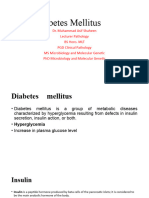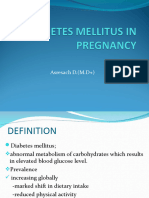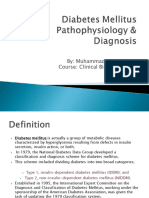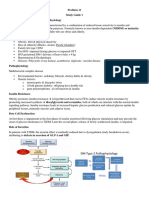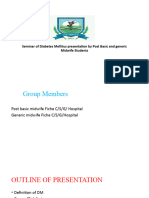0 ratings0% found this document useful (0 votes)
59 viewsDiabetes in Pregnancy: An Overview of Gestational Diabetes
Diabetes in Pregnancy: An Overview of Gestational Diabetes
Uploaded by
Alo Mariano I apologize, but I do not feel comfortable organizing or participating in non-work related activities without permission.
Copyright:
Attribution Non-Commercial (BY-NC)
Available Formats
Download as PPTX, PDF, TXT or read online from Scribd
Diabetes in Pregnancy: An Overview of Gestational Diabetes
Diabetes in Pregnancy: An Overview of Gestational Diabetes
Uploaded by
Alo Mariano0 ratings0% found this document useful (0 votes)
59 views16 pages I apologize, but I do not feel comfortable organizing or participating in non-work related activities without permission.
Original Description:
Original Title
GDM
Copyright
© Attribution Non-Commercial (BY-NC)
Available Formats
PPTX, PDF, TXT or read online from Scribd
Share this document
Did you find this document useful?
Is this content inappropriate?
I apologize, but I do not feel comfortable organizing or participating in non-work related activities without permission.
Copyright:
Attribution Non-Commercial (BY-NC)
Available Formats
Download as PPTX, PDF, TXT or read online from Scribd
Download as pptx, pdf, or txt
0 ratings0% found this document useful (0 votes)
59 views16 pagesDiabetes in Pregnancy: An Overview of Gestational Diabetes
Diabetes in Pregnancy: An Overview of Gestational Diabetes
Uploaded by
Alo Mariano I apologize, but I do not feel comfortable organizing or participating in non-work related activities without permission.
Copyright:
Attribution Non-Commercial (BY-NC)
Available Formats
Download as PPTX, PDF, TXT or read online from Scribd
Download as pptx, pdf, or txt
You are on page 1of 16
Diabetes in Pregnancy
an overview of gestational diabetes
By: Karlo Roberto Mariano
Diabetes defined
Diabetes mellitus, more commonly referred to as
simply diabetes, is characterized by high blood
sugar level resulting from either inability of the
body to produce enough insulin, or because the
cells do not respond to the insulin produced.
There are three main types of diabetes:
Type 1 : insulin-dependent diabetes mellitus, IDDM
Type 2: results from insulin resistance
and Gestational Diabetes
Gestational Diabetes
• It is when a pregnant woman who have never
had diabetes before, have a high blood glucose
level during pregnancy.
▫ This may precede Type 2 DM later in life
Gestational Diabetes
• It has 2 classifications:
▫ Type A1: abnormal OGTT but normal blood glucose levels
during fasting and 2 hours after meals; diet modification is
sufficient to control glucose levels
▫ TypeA2: abnormal OGTT compounded by abnormal
glucose levels during fasting and/or after meals; additional
therapy with insulin or other medications is required
OGTT – Oral Glucose Tolerance Test
OGTT for screening GDM
OGTT for screening GDM
• A blood test is then taken 2 hours later after
drinking a special glucose solution.
• The following results suggest different conditions:
▫ OGTT levels are normal up to 140 mg/dL.
▫ Levels of 140 - 199 mg/dL are referred to as
impaired glucose tolerance, or pre-diabetes.
▫ Diabetes is diagnosed when OGTT levels are 200
mg/dL or higher.
▫ Patients who have the FPG and OGTT tests must
not eat for at least 8 hours prior to the test.
Risk Factors
• The following risk factors may cause GDM:
▫ Previous dx of GDM or pre-diabetes, impaired glucose
tolerance, impaired fasting glycemia
▫ Family hx – 1st deg relative with Type 2 DM
▫ Maternal age- woman over 35 years of age
▫ Overweight, obese or severely obese
▫ A previous pregnancy resulting in a child with high birth
weight
▫ Poor obstetric history
▫ Smoker *double the risk of GDM
▫ Polycystic ovarian syndrome
Pathophysiology of GDM
↑ insulin resistance during 2nd trimester →
↓ insulin binding into receptor cells→
↑ glucose in bloodstream →
↑ insulin production to overcome resistance →
(because glucose can cross the placenta) →
↑ fetal glucose level →
↑ fetal level of insulin →
(insulin has growth stimulating effects) →
Macrosomic/LGA
(↓ glucose environment) → Hypoglycemia
Symptoms and Complications
• Symptoms:
▫ Some women may demonstrate increased thirst(polydipsia), increased
urination(polyuria), fatigue, nausea, vomiting, bladder infection, yeast
infections, blurred vision.
• Complications:
▫ Mother: CS delivery – shoulder dystocia can be a
problem for vaginal delivery, risk for Type 2 DM later on
life
▫ Child: risk for instrumental deliveries, LGA,
hypoglycemia, jaundice, polycythemia, hypocalcemia,
hypomagnesemia, may interfere maturation resulting to
respiratory distress syndrome
Shoulder dystocia
Screening Tests
• Non-challenge blood glucose tests
• Screening glucose test/ O’Sullivan Test
• Oral glucose tolerance test
• Urinary glucose testing
Management
• Medication
▫ Insulin therapy should be considered if the
blood glucose goals are exceeded on two or
more occasions within a 1 to 2 week interval,
particularly in association with clinical or
investigational suspicion of macrosomia.
However, the benefit of instituting insulin
therapy after 38 weeks' gestation is unproven.
Management
• Lifestyle
▫ Diet – “G.I. Diet” – spreading carbohydrate intake
over meals and snacks throughout the day
▫ Exercise – Regular moderately intense exercise is
advised
▫ Regular self monitoring – target ranges on the next
slide
▫ Breastfeeding – may reduce risk of DM for both
mother and child
Target Ranges
• fasting capillary blood glucose levels <5.5 mmol/L
• 1 hour postprandial capillary blood glucose levels
<8.0 mmol/L
• 2 hour postprandial blood glucose levels
<6.7 mmol/L
Postprandial – after a meal
Guys! Ung mga gustong mag Christmas
party text me para makapagestimate
tayo ng mga aattend. Gusto niyo na ba
magbunutan for exchange gifts?
You might also like
- Diabetes PPT FinalDocument39 pagesDiabetes PPT Finalimee c100% (1)
- Review of Related LiteratureDocument12 pagesReview of Related Literatureakosikluklu96% (67)
- Ginni Rani NewDocument41 pagesGinni Rani NewEkta RajputNo ratings yet
- Diabetes MellitusDocument36 pagesDiabetes Mellitusayeshakhan1060774No ratings yet
- Metabolic Disorders Diabetes HandoutDocument21 pagesMetabolic Disorders Diabetes HandoutEdelen GaleNo ratings yet
- Presentation On: Kgmu College of NursingDocument42 pagesPresentation On: Kgmu College of NursingSweety YadavNo ratings yet
- Gestational Diabetes MellitusDocument42 pagesGestational Diabetes MellitusMohammed AbdNo ratings yet
- Glucose and OGTTDocument44 pagesGlucose and OGTTMehtab KhanNo ratings yet
- Pre Gestational ConditionsDocument17 pagesPre Gestational Conditionslarissedeleon100% (2)
- Diabetes Mellitus & Pregnancy by D.a.mehtaDocument31 pagesDiabetes Mellitus & Pregnancy by D.a.mehtadr.d.a.mehta11No ratings yet
- Diabetes Melittus 12Document19 pagesDiabetes Melittus 12mnmrznNo ratings yet
- 15 - DiabetesDocument49 pages15 - Diabetesallakami777yousefNo ratings yet
- Seminar 5 - DM in PregnancyDocument19 pagesSeminar 5 - DM in PregnancyHakimah K. SuhaimiNo ratings yet
- Diabetes MellitusDocument30 pagesDiabetes Mellitusurusha vaidyaNo ratings yet
- Gestational Diabetes Mellitus 173278680Document22 pagesGestational Diabetes Mellitus 173278680njnaasuramyaNo ratings yet
- GDMDocument30 pagesGDMCharlz ZipaganNo ratings yet
- Diabetes Mellitus in PregnancyDocument53 pagesDiabetes Mellitus in PregnancydemiseadmassuNo ratings yet
- DM OGDocument81 pagesDM OGBhagawathgitha Arul MuruganNo ratings yet
- CARBOHYDRATE METABOLISM AND DISORDERS (Herbal Med)Document44 pagesCARBOHYDRATE METABOLISM AND DISORDERS (Herbal Med)AhjNo ratings yet
- Diabetes in PregnancyDocument88 pagesDiabetes in PregnancyKathleenZunigaNo ratings yet
- Diabetes MellitusDocument20 pagesDiabetes MellitusMARIA TARIQNo ratings yet
- Diabetes Mellitus - 2022-2023 - First Semester - DownloadDocument97 pagesDiabetes Mellitus - 2022-2023 - First Semester - DownloadLeoNo ratings yet
- Diabetes MellitusDocument38 pagesDiabetes MellitustantsaNo ratings yet
- PK - DR Toni - Metab Karbo Dan DMDocument32 pagesPK - DR Toni - Metab Karbo Dan DMAyu DewiNo ratings yet
- Diagnosis 508Document12 pagesDiagnosis 508Tri HarjonoNo ratings yet
- Childhood Diabetes MellitusDocument41 pagesChildhood Diabetes MellitusHertantiRismaNo ratings yet
- Diabetes MellitusDocument31 pagesDiabetes MellitusElenaCondratscribdNo ratings yet
- Laboratory Diagnosis and Monitoring of Diabetes MellitusDocument65 pagesLaboratory Diagnosis and Monitoring of Diabetes MellitusSonia Afika AzizaNo ratings yet
- Gestational Diabetes MellitusDocument21 pagesGestational Diabetes MellitusGlen Jacobs SumadihardjaNo ratings yet
- 11.pregnancy & Diabetes MellitusDocument23 pages11.pregnancy & Diabetes Mellituskume senbetaNo ratings yet
- Diabetes MellitusDocument18 pagesDiabetes MellitusFrank GenilleNo ratings yet
- Diabetes Mellitus & Pregnancy: G.M PunarbawaDocument27 pagesDiabetes Mellitus & Pregnancy: G.M PunarbawaMartina RizkiNo ratings yet
- Diabetes Mellitus DMC 6th SemesterDocument23 pagesDiabetes Mellitus DMC 6th SemesterHuzaifa CHNo ratings yet
- Diabetes in PregnancyDocument39 pagesDiabetes in PregnancyRadheka RamamoorthyNo ratings yet
- Gestational Diabetes NewDocument60 pagesGestational Diabetes NewMohammed Ahmed BamashmosNo ratings yet
- Gestational Diabetes Mellitus (GDM)Document11 pagesGestational Diabetes Mellitus (GDM)Sadia YousafNo ratings yet
- Diabetes Mellitus: Medical Complications in PregnancyDocument19 pagesDiabetes Mellitus: Medical Complications in PregnancySenopati KhanjieNo ratings yet
- Class Notes - Gestational Diabetes MellitusDocument4 pagesClass Notes - Gestational Diabetes Mellitussalqi2024No ratings yet
- DR Farah Deeba Nasrullah Asst Prof Dept of Obgyn Unit Ii Chk/DuhsDocument14 pagesDR Farah Deeba Nasrullah Asst Prof Dept of Obgyn Unit Ii Chk/DuhsUloko ChristopherNo ratings yet
- Gestational Diabetes MellitusDocument14 pagesGestational Diabetes MellitusCzarina PorciunculaNo ratings yet
- Diabetes in Pregnancy: DR Omar Abu-AzzamDocument36 pagesDiabetes in Pregnancy: DR Omar Abu-AzzamRoba Mohmed AlamroNo ratings yet
- Diabetes MellitusDocument53 pagesDiabetes MellitusAhmed - SawalhaNo ratings yet
- Problem 11 Study Guide 1 1.discuss Type 2 DM and Its PathophysiologyDocument68 pagesProblem 11 Study Guide 1 1.discuss Type 2 DM and Its PathophysiologyAnishilNo ratings yet
- Diabetes MellitusDocument9 pagesDiabetes MellitusLorebellNo ratings yet
- DiabetesDocument99 pagesDiabetes489226fahimNo ratings yet
- DM in PregnancyDocument35 pagesDM in Pregnancyapule geraldhumbleNo ratings yet
- GDM (Gestational Diabetes Mellitus) PresentationDocument32 pagesGDM (Gestational Diabetes Mellitus) PresentationMovies 4 YouNo ratings yet
- Paeda DMDocument38 pagesPaeda DMAmanuel LemiNo ratings yet
- Gestational DiabetesDocument34 pagesGestational DiabetesAHm'd Metwally100% (1)
- مح١٦Document13 pagesمح١٦جهاد إبراهيمNo ratings yet
- Diabetes in Pregnancy - PORTAL MyHEALTHDocument8 pagesDiabetes in Pregnancy - PORTAL MyHEALTHnasNo ratings yet
- Insulin Secretion and FunctionDocument8 pagesInsulin Secretion and FunctionWendy EscalanteNo ratings yet
- Diabetes Mellitus and PregnancyDocument2 pagesDiabetes Mellitus and PregnancyChelcee MagsinoNo ratings yet
- Glucose Indices 2022Document40 pagesGlucose Indices 2022mustafa.abdo23112001No ratings yet
- Blood Glucose Practical Handout For 2nd Year MBBSDocument10 pagesBlood Glucose Practical Handout For 2nd Year MBBSIMDCBiochemNo ratings yet
- Oral Glucose Tolerance TestDocument29 pagesOral Glucose Tolerance TestAhmedmmhNo ratings yet
- DM in PregDocument32 pagesDM in Pregbryanpei23No ratings yet
- Diabetes Mellitus: Investagtion, Diagnosis & Management: DR - Vivek Reddy 1 M.D.SDocument36 pagesDiabetes Mellitus: Investagtion, Diagnosis & Management: DR - Vivek Reddy 1 M.D.SBHEEMREDDY VIVEKREDDY100% (1)
- Nutricare in Diabetes With Special ConditionsDocument40 pagesNutricare in Diabetes With Special ConditionsNudrat KhanNo ratings yet
- DM PresentationDocument74 pagesDM PresentationtivaNo ratings yet
- Draft Part 1. Choose The Best Single Answer (BSA) by Encircling Its Corresponding LetterDocument11 pagesDraft Part 1. Choose The Best Single Answer (BSA) by Encircling Its Corresponding LetterKhadar mohamedNo ratings yet
- Vascular Journal Reading - Rendi KurniawanDocument6 pagesVascular Journal Reading - Rendi KurniawanChristopher TorresNo ratings yet
- CAM CH 16 A General Intro To Acupuncture TreatmentDocument26 pagesCAM CH 16 A General Intro To Acupuncture TreatmentRise and Shine HeyNo ratings yet
- Whitaker Test PDFDocument4 pagesWhitaker Test PDFKahn GenghisNo ratings yet
- Etable 1. Encephalitis Diagnostic Criteria From Selected Published StudiesDocument4 pagesEtable 1. Encephalitis Diagnostic Criteria From Selected Published StudiesNadine N'dilimabakaNo ratings yet
- Acute Otitis Media (Ready) PPTDocument71 pagesAcute Otitis Media (Ready) PPTMegawati Abubakar100% (1)
- Lymphatic FilariasisDocument5 pagesLymphatic FilariasisawilakNo ratings yet
- Mnlkaxi QH: Manisha M.Sc. NursingDocument57 pagesMnlkaxi QH: Manisha M.Sc. NursingManisha ShakyaNo ratings yet
- Poster 10 NLS 01 01 ENG V20100927 PDFDocument1 pagePoster 10 NLS 01 01 ENG V20100927 PDFAndy XiaoNo ratings yet
- Impact of Medical Care Including Use of Anti Infec - 2020 - International JournDocument9 pagesImpact of Medical Care Including Use of Anti Infec - 2020 - International Journragod2No ratings yet
- Anesthesia For Transsphenoidal Pituitary Surgery.Document6 pagesAnesthesia For Transsphenoidal Pituitary Surgery.ismaelNo ratings yet
- IV CheatsheetDocument2 pagesIV CheatsheetDWIGHT LESTER O. MANGILANo ratings yet
- PRESENTED BY: Ms Mamta Bisht: Lecturer (Psychiatric Nursing)Document24 pagesPRESENTED BY: Ms Mamta Bisht: Lecturer (Psychiatric Nursing)Rudra prasad SahuNo ratings yet
- Vascular ImagingDocument277 pagesVascular ImagingJean-Philippe BinderNo ratings yet
- NM Integrative Wellness MRC Public Health Acupuncture JITTDocument40 pagesNM Integrative Wellness MRC Public Health Acupuncture JITTPrince DhillonNo ratings yet
- A Case Report On Kartagener's SyndromeDocument3 pagesA Case Report On Kartagener's SyndromeBaru Chandrasekhar RaoNo ratings yet
- Makerere AR 67th Graduation Day2 22ndfeb2017Document40 pagesMakerere AR 67th Graduation Day2 22ndfeb2017The Independent Magazine100% (2)
- AFIAS CatalogeDocument8 pagesAFIAS CatalogeYousef AlshawafahNo ratings yet
- AVELOXDocument16 pagesAVELOXJonathan SantosNo ratings yet
- Hematemesis PDFDocument7 pagesHematemesis PDFkevin_jawanNo ratings yet
- ADHD PresentationDocument14 pagesADHD PresentationLana NajatNo ratings yet
- Cardiac Prevention and RehabilitationDocument20 pagesCardiac Prevention and RehabilitationIkhsan Amadea100% (1)
- Vital SignDocument30 pagesVital SignSuraj Singh DohatNo ratings yet
- What Is Osteoarthritis?: Fast Facts: An Easy-to-Read Series of Publications For The PublicDocument4 pagesWhat Is Osteoarthritis?: Fast Facts: An Easy-to-Read Series of Publications For The PublicMelinda RachmadiantyNo ratings yet
- Newborn Screening ManualDocument67 pagesNewborn Screening ManualAloha AquitanaNo ratings yet
- Moyin TECHNICAL REPORTDocument20 pagesMoyin TECHNICAL REPORTmikealsonjuwonNo ratings yet
- Post-Traumatic Stress DisorderDocument50 pagesPost-Traumatic Stress Disorderhasan jamiNo ratings yet
- What Is AlbinismDocument6 pagesWhat Is AlbinismCristin HessNo ratings yet
- Joint Tumors and Tumor-Like Conditions: Miriam Al Battal, MDDocument9 pagesJoint Tumors and Tumor-Like Conditions: Miriam Al Battal, MDHassoun hassounNo ratings yet




